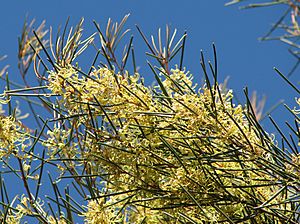Hooked needlewood facts for kids
Quick facts for kids Hooked needlewood |
|
|---|---|
 |
|
| Scientific classification | |
| Genus: |
Hakea
|
| Species: |
tephrosperma
|
Hakea tephrosperma, commonly known as hooked needlewood, is a cool plant! It's a type of shrub or small tree that belongs to the Proteaceae family. This plant is one of the taller Hakea species and can grow well in both dry and mild (temperate) places.
What it Looks Like
The hooked needlewood is a big, upright shrub or a small tree. It can grow up to 8 m (26 ft) tall! It often has many stems and can regrow from a special woody base called a lignotuber if it gets damaged.
Its smaller branches are often a rusty color. They might have smooth, silky hairs or be covered in thick, soft, white, woolly hairs.
The leaves of this plant are shaped like needles. They are smooth and can be 3–8 cm (1–3 in) long and 1–1.8 mm (0.04–0.07 in) wide. Each leaf ends with a small, curved hook that is about 0.8–2 mm (0.03–0.08 in) long.
Flowers and Fruit
The flowers grow in clusters called an inflorescence. These clusters have a short, red-brown stalk, about 1–3 mm (0.039–0.12 in) long, covered in fine, soft hairs. Each cluster holds between 6 and 22 individual flowers.
Each flower has its own small stalk, called a pedicel, which is about 3.5–7 mm (0.1–0.3 in) long. The flower parts, known as the perianth, are white and red-brown. They are also covered in fine, soft, matted hairs.
Cream-colored flowers appear in groups called Racemes where the leaves meet the stem. You can usually see them blooming between September and October.
After the flowers, the plant produces egg-shaped fruits. These fruits are mostly smooth and measure about 2–3 cm (0.8–1 in) long and 1.5–2 cm (0.59–0.79 in) wide. Sometimes, they have small, blister-like bumps. The fruit ends with two blunt, noticeable "horns" that can be up to 2 mm (0.08 in) long.
How it Got its Name
Hakea tephrosperma was first officially described by a botanist named Robert Brown in 1830. He wrote about it in a book called Supplementum primum prodromi florae Novae Hollandiae.
The second part of its scientific name, tephrosperma, comes from two Ancient Greek words. Tephros means "ash-colored" and sperma means "seed". So, the name refers to the ash-colored seeds of the plant.
Where it Grows
The hooked needlewood is a common plant found in drier parts of Australia. You can find it in Queensland, New South Wales, Victoria, and South Australia.
It usually grows in open areas with plants like spinifex grass and blue-bush (which are Maireana species). It can grow as a single tree or in thick groups on rough soils. Even though it can adapt to both dry and mild climates, you don't often see it planted in gardens.

